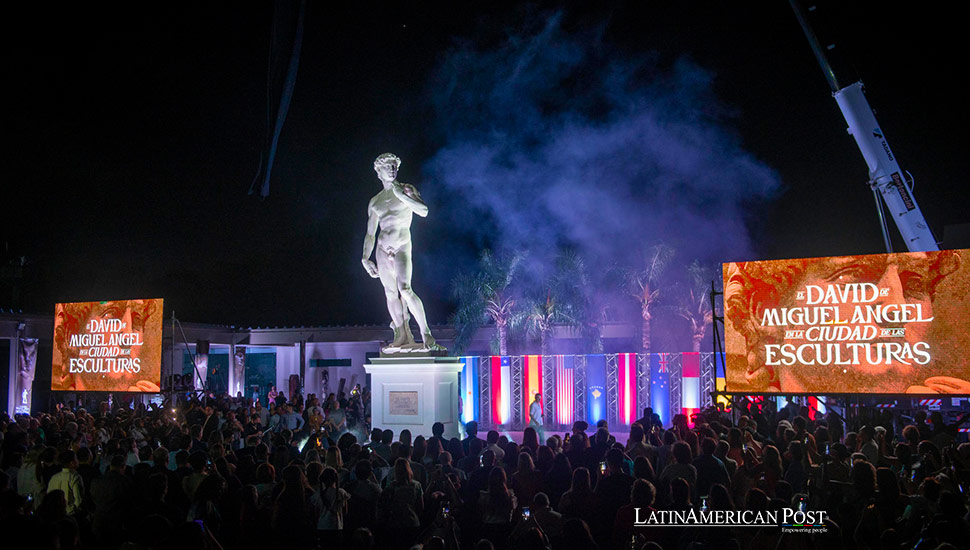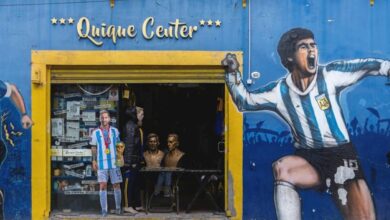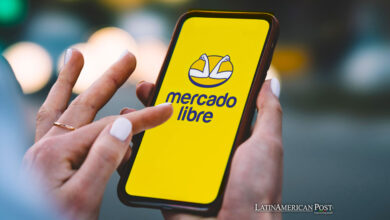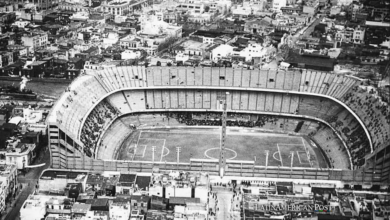Argentine City Celebrates Its Own Michelangelo’s David

In a remarkable testament to artistic innovation, the northern Argentine city of Resistencia has unveiled a 21st-century replica of Michelangelo’s David. This unique replica, a product of cutting-edge technology and the city’s deep-rooted love for sculpture and public art, stands as a symbol of Resistencia’s artistic prowess.
Amid the vibrant cultural landscape of Resistencia, the capital of Chaco province, a new monumental sculpture stands tall. This 5-meter replica of Michelangelo’s David, identical to the original in the Accademia Gallery of Florence, now graces the city’s public space, underscoring Resistencia’s moniker as the “City of Sculptures.”
Resistencia boasts nearly 700 sculptures across its streets, parks, and plazas, reflecting a long-standing tradition of integrating art into public spaces. This tradition began over 60 years ago, spearheaded by the founders of the city’s most celebrated cultural hub, the Fogón de los Arrieros. Their initiative to embellish public areas with art has since flourished, leading to the establishment of the Bienal Internacional de Escultura, a significant cultural event held every two years.
José Eidman, president of the Fundación Urunday and organizer of the Bienal Internacional de Escultura, explains the city’s deep connection with public art. “The story of Resistencia is a love affair with sculpture that has lasted over six decades,” Eidman shared. The foundation, instrumental in bringing a replica of David to Resistencia, has continuously promoted the city’s artistic heritage.
The dream of having a replica of Michelangelo’s David in Resistencia began to take shape in 2020. It was the brainchild of the esteemed Chaco sculptor Fabriciano Gómez (1944-2021), who was a driving force behind the city’s first national open-air sculpture competition and a founding member of Fundación Urunday. Gómez envisioned Resistencia, already renowned in the art world, as a city that could proudly display one of the most iconic sculptures in history.
This vision found a pivotal moment in 1910, during the celebrations of Argentina’s Centennial of Independence, when a first-cast replica of David arrived. This replica is now preserved in the Museo de Calcos y Escultura Comparada Ernesto de la Cárcova in Buenos Aires. “The challenge was immense: creating a reproduction from this first-cast replica and bringing it to Resistencia,” Eidman explained.
Innovative Techniques
The journey to create the David replica required overcoming significant technical challenges. The Universidad Nacional de las Artes, which oversees the museum housing the original replica, did not authorize using traditional techniques, as they would involve applying materials and weight that could damage the original. Instead, a non-invasive method had to be found.
The solution was found through cutting-edge technology. “We researched and found an incredible team adept at high-precision 3D technology,” Eidman said. Sculptors Gisela Kraisman and Denise Di Federico, who undertook the project, were enthusiastic about the possibilities. “We knew we could do it but hadn’t done it before. This was our opportunity,” Kraisman shared.
After obtaining the necessary permissions, the team performed a high-definition digital scan of the original replica. This digital twin of Michelangelo’s David enabled them to create molds from which the final replica would be cast. “We made a traditional cast within 3D-printed molds,” Kraisman detailed. Using nautical resins, fibers, and calcium carbonate, materials that harden and resemble stone but are three times lighter and weather-resistant, they crafted the replica.
The assembly involved fitting 158 fragments onto a metal skeleton designed by engineers from the Universidad Nacional del Nordeste. “The creation process took about five months and demanded around-the-clock dedication,” Di Federico recounted. We poured our soul, love, and energy into it.”
The realization of the David replica was a collective endeavor, a testament to the passion and determination of Resistencia’s community. This project, born out of immense love for art and the city, embodies the spirit and artistic legacy of Resistencia.
Latin American Context
The installation of David in Resistencia is a local achievement and part of a broader Latin American tradition of public art and cultural expression. Latin America, with its rich history of integrating art into public spaces, from the murals of Mexico City to the vibrant street art of Bogotá and São Paulo, is a testament to the region’s depth and richness of artistic traditions. These artistic expressions serve as a means of social commentary, cultural identity, and community pride, reflecting the vibrant and diverse cultures of the region.
Resistencia’s dedication to public art can be seen as part of this more significant movement, where cities across Latin America embrace and promote their cultural heritage through accessible art. The Bienal Internacional de Escultura in Resistencia aligns with other important cultural events in the region, such as the Havana Biennial and the São Paulo Art Biennial, which celebrate and showcase contemporary art.
Michelangelo’s David is one of the most recognized sculptures in the world. It symbolizes the Renaissance’s artistic achievements and humanism. The original statue, created between 1501 and 1504, represents the biblical hero David and is renowned for its detailed anatomy and expressive power. The statue’s presence in Florence has made it a cultural landmark, drawing millions of visitors annually.
Bringing a replica of David to Resistencia is not just a local achievement, but a significant part of a broader Latin American tradition of public art and cultural expression. This connection to a rich cultural heritage allows residents and visitors to experience the universality of art, how a masterpiece can inspire and resonate across different cultures and continents.
The Future of Public Art in Resistencia
The unveiling of David is a significant milestone for Resistencia, but it is just one part of the city’s ongoing commitment to public art. The upcoming Bienal Internacional de Escultura, scheduled for July 13-21, will add new works to the city’s collection, continuing the tradition of enriching public spaces with art. This future of public art in Resistencia is a beacon of hope and excitement, promising a vibrant and dynamic cultural landscape for the city and its future generations.
These events enhance the city’s aesthetic appeal and contribute to its cultural and economic vitality. Public art attracts tourists, fosters community pride, and provides educational opportunities. By promoting art and culture, Resistencia invests in its future, ensuring that it remains a vibrant and dynamic place for future generations.
Resistencia’s new replica of Michelangelo’s David is more than just a sculpture; it symbolizes the city’s artistic dedication and connection to global cultural heritage. This achievement reflects the passion and perseverance of a community that values art and recognizes its importance in public life.
Also read: Conexión Buenos Aires: Bridging Argentine Culture with the World
As Resistencia continues to celebrate and promote its artistic legacy, it is a shining example of how public art can transform a city, inspire its residents, and connect with the world. The story of David in Resistencia is a testament to the enduring power of art and the collective efforts of a community to bring a dream to life.





